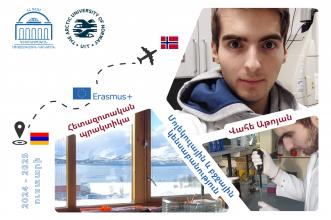Erasmus+ Research Internship: Vahe Atoyan, The Arctic University of Norway
October 29, 2025
Vahe Atoyan, a remarkable 2025 graduate of the master’s program in “Molecular and Cellular Biology” at the International Scientific-Educational Center of the National Academy of Sciences of Armenia (ISEC NAS RA), had the opportunity—twice—to complete a research internship at the Arctic University of Norway (UiT) through the Erasmus+ program during his studies at ISEC.
Within the Erasmus+ program linked to the project 22IRF-10 “Impact of Climate Change in Armenia: A Comprehensive Approach to the Study of Plant Biodiversity,” funded by the RA Ministry of Education, Science, Culture, and Sports’ Committee of Higher Education and Science, he took part in joint research at the Climate Laboratory of UiT, focusing on improving plant stress tolerance. In this interview, Vahe shares his experience of the international internship.
– Vahe, why did you decide to participate in the mobility program?
– When I familiarized myself with the program’s content, I became very interested because it included the study of important and modern applied methods in my field. Additionally, it was a great opportunity to experience a foreign country, a new culture, and to travel. I was particularly fascinated by the Arctic location of the university, as I personally enjoy cold climates.
– What spiritual or intellectual values did you take with you to represent Europe?
– The solid theoretical knowledge I gained during my master’s studies helped me quickly adapt to practical work in the new laboratory. I also hope that my diligence, teamwork skills, and ability to learn fast left a good impression—qualities that, in my opinion, contributed to my being invited for a second visit.
– What did you gain from the host university?
–At the host university, I gained valuable professional and practical skills, made new friends, expanded my worldview, and connected with mentors and colleagues with whom I still maintain contact. Of course, I also had the unique experience of living in the Arctic region. I learned to master advanced non-destructive scanning methods and improved my laboratory skills. I gained experience in organizing and conducting large-scale research, collecting data, and doing preliminary analyses. During the internship, I became familiar with several modern laboratory and analytical techniques and was able to apply them in practice. I performed DNA extraction, PCR, and barcoding for the molecular identification of plant samples. In addition to molecular methods, I utilized hyperspectral cameras and PlantEye 3D laser-multispectral scanners to investigate the structural and physiological parameters of plants. This experience not only strengthened my theoretical knowledge but also allowed me to develop practical skills in data collection, processing, and analyzing results.
– What is the title of your master’s thesis, and how did your visit to Norway contribute to it?
– My master’s thesis is titled “Expanding the Capabilities of Hyperspectral Imaging for the Identification of Armenian Vaccinium Species.” I conducted the main experimental work in Norway and completed data analysis and thesis writing after returning to Armenia.
– Compare yourself before and after participating in the Erasmus+ program.
– After participating in Erasmus+, I gained valuable hands-on experience working in a laboratory and became more independent in my work. My interests in certain specialized subfields also developed. Along with professional growth, I became more self-reliant and communicative.
– How did you get the opportunity to participate twice in Erasmus+ at the same host university?
– During my first visit, I had already become a full member of the laboratory—both in terms of work performance and communication with the team. Therefore, I wanted to complete my final project there, and I decided to apply again for the Erasmus+ program for the next semester.
– How important is it for Armenian students to participate in mobility programs?
– In my opinion, for students focusing on scientific fields, participating in mobility programs is very important. It offers the chance to gain experience, become familiar with the international scientific community, and later engage in joint projects and research collaborations.
– How satisfied are you with your participation in this program?
– I am very pleased with both the program and the environment. From the moment I submitted my application until I finished, I received full support from my supervisors, ISEC, and the host university (UiT), for which I am very grateful.
– You graduated from ISEC with honors. How and where do you plan to apply the professional knowledge and experience you gained in Armenia and Norway?
– I plan to continue working in the field of science and apply my knowledge in Armenia, and when needed, participate in international joint scientific projects.
– What advice would you give to students who haven’t participated yet or are unsure about joining such programs?
– I would definitely encourage other students to take part in such programs, as they are a great opportunity to acquire professional skills, make new connections, and travel. I would also advise them to improve their English and apply confidently for international mobility programs.
The accompanying video features scenes from Vahe’s Norwegian internship, showcasing a laboratory study on the response of forest strawberries to climate change, working on various research methods.
Interview conducted by:
Heghine Melkonyan, Head of the Public Relations
and Career Department, ISEC NAS RA

